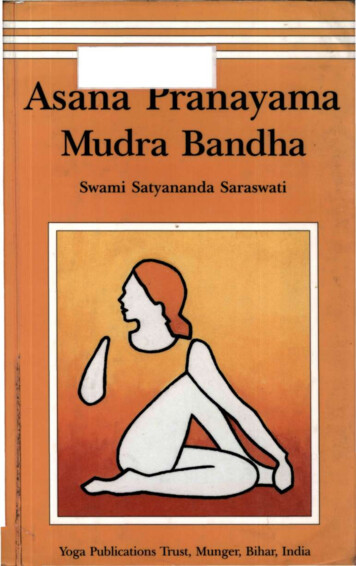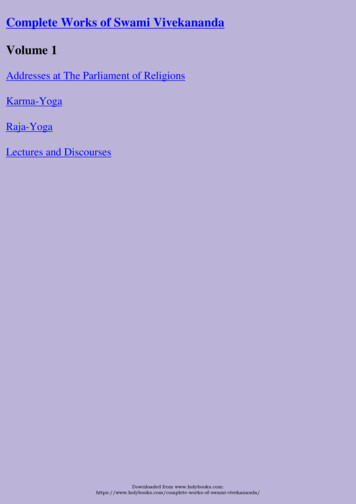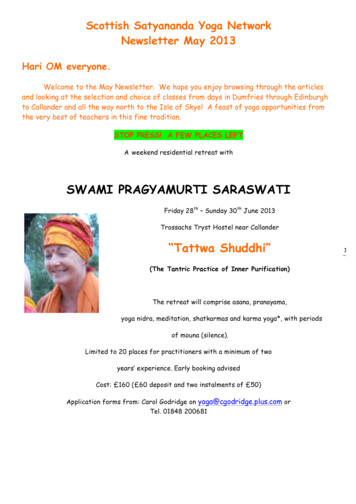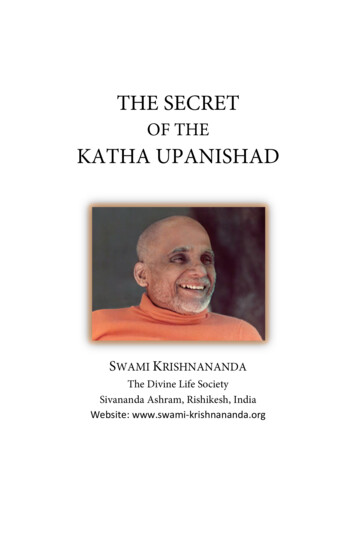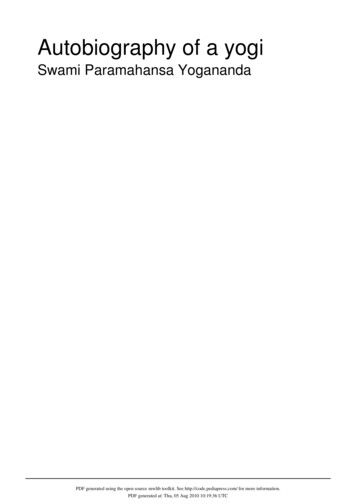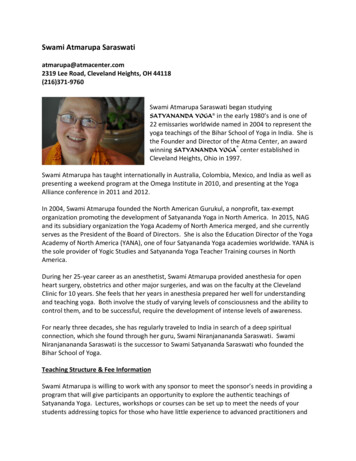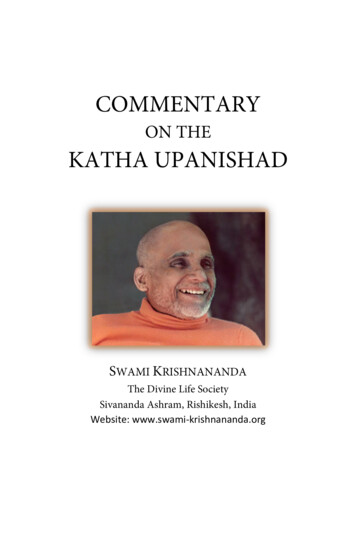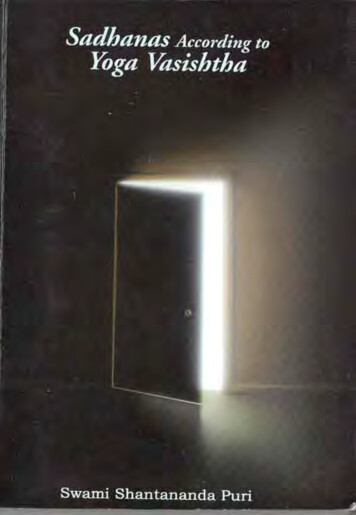
Transcription
SADHANASACCORDING TOYOGA VASISHTHASwami Shantananda PuriParvathamma c.P. Subbaraju SettyCharitable Trust# 13/8, Pampa Mahakavi RoadShankarapuram, Bangalore - 560 004
SAD HANAS ACCORDING TO YOGA VASISHTHAAuthorSri Swami Shantananda Puri PublisherParvathamma c.P. Subbaraju SettyCharitable TrustSADHANASACCORDING TOYOGA VASISHTHA13/8, PMK RoadBangalore - 560004.First EditionJuly 2005(Guru Poomima)Cover PageDesignP.Y.AshwiniType Setting& PrintingOmkar Offset PrintersI st Main Road, New TharagupetBangalore - 560002Ph: 26708186,26709026.e-mail: omkar@blr.vsnl.net.inwebsite: www.omkarprinters.comiiiii
SAMARPANThis book is dedicated with venerationto the Lotus Feet of my revered GuruSwami Purushottamanandajiof Vasishtha Guha, Uttaranchal, Himalayas,but for whose infinite CompassionI would not have been able to formulatemy thoughts and put them downin this bookandto the thousands of SpiritualSadhakas all over the world.- Swami Shantananda Puriiv""'H.H. Srima{[ Swami Shanfallan(/a Puri Maharuj
INSIDEPage No.IINTRODUCTIONIIVAIRAGYA PRAKARANA5IIIMUMUKSHUPRAKARANA12NUTPATTI PRAKARANA20VSUMMING UP73v
IntroductionYoga Vasishtha also known as Vasishtha MahaRamayana is one of the greatest classics in AdvaitaVedanta. Its importance and greatness have beenextolled by many a scholar like Swami Ramtirtha,Dr. Ganganath Jha, Bhagavan Das etc. Many of theverses in Upanishads like Maha Upanishad,Annapuma Upanishad etc. are found repeated inYoga Vasishtha. This is one of the best scriptures onSelf-knowledge. It is said that whatever is not foundin this book cannot be found elsewhere and whateveris contained in other texts is all to be found in thisbook.This text has been divided into six prakaranas(parts) called Vairagya, Mumukshu, Utpatti, Sthiti,Upasana and Nirvana respectively and is supposedto contain in all 32,000 verses (Actually the total asavailable is only about 28,000). The author of thistext is Valmiki, the author of 'Ramayana'. The bookis mainly in the form of instructions from Vasishthato Sri Rama who was disgusted with his normal life1
of a prince and was prepared to end his life byfasting. In this cunent booklet, an attempt has beenmade to summarise the subject matter of the firstthree prakaranas only highlighting the Sadhanasprescribed for a seeker. In addition, a gist of the storyof Chudala & Sikhidhwaja from the last prakarana(Nirvana Prakarana) has been included as it is aIn rare places as when Valmiki says that "theone who is convinced that he is liberated is trulyliberated and the one who considers himself boundremarkable story containing certain essential teachings.But this summary can be.held to be a representativebrief presentation of the subject matter of the entireoriginal text (i.e. 6 prakaranas), as the balance threeparts contain only a repetition of the theme coveredin the first three parts by elaborately illustrating themwith various parable-like stories and examples.date of composition of this book. As far as realThe influence of "Gaudapada's Karika onMandukya Upanishad" on Yoga Vasishtha e.g., AjataVada (the theory of non-creation) and the exampleof the Alata (firebrand) is clearly seen. Yoga Vasishthais famous for a number of unique stories. This hasbeen quoted often by Vidyaranya in Panchadasi (hehas cited this work by name and has quoted asmany as 253 verses from it).Those who cannot go through the original text2remains bound", one is reminded of AshtavakraSamhita.It is the scholars who are bothered about theaspirants are concerned, they should only be contentwith the savour of the excellent contents of thebook. Anybody with some insight should be able tobe convinced that whosoever had written YogaVasishtha must necessarily have been a realised soulof a high order.will do well to go through at least "Laghu YogaVasishtha" in which Sri Abhinand Pandit has selected6000 verses out of the original text. The slokas ofbooks like Yoga Vasishtha should not be read like astory book. The meaning of each sloka or 4 or 5 ofthem should be meditated upon daily for hours sothat it will seep into our inner being and transform us.3
PART IThe philosophy of this text is meant mainly forhouseholders so that they can practise it whileleading their normal life.By just reading or hearing the highest truthscontained in Yoga Vasishtha, by constantlycontemplating and mulling over them, it becomes aSadhana and it can lead one to the samadhi stage.This book would not be possible without thesupport of my friend Sri D.N. Anand who has beena great source of strength in printing meticulously.May the Divine Mother bless him and his familywith all the best in life.As usual, Sri P.S. Venkatesh Babu and hisassociates in MIs. Omkar Offset Printers have printedthe book in an exquisitely beautiful way. May theycontinue to prosper in all walks of life.A very thoughtful and beautiful cover designhas been provided by young P.V Aswini. MayDivine Mother bless her with all the best in life.(Dispassion and Detachment)Yoga Vasishtha begins with a postulate thatliberation is not possible by flerformance of Karma(acts prescribed in scriptures) alone or by Jnana(knowledge) alone but that both together, inconjuction, constitute the means therefor. The bookis mainly in the form of an exhortation by the greatsage Vasishtha to Rama(the hero of the Ramayana),when the latter was seized at the age of fifteen, withan intense disgust for worldly life soon after hereturned from a long pilgrimage to all the importantholy places.DESIRE - THE CAUSE OF ALL MISERIESAccording to Valmiki, the author of this book,it is our desire! for worldly objects which sustainsthe body-mind complex and thus leads us into1.HariOm4V AIRAGYA PRAKARANAShantananda Puri5
bondage. In reality, the entire world is only anRama when asked by Vasishtha and Visvamitra, twoappearance like dream objects. The conviction2great sages, to explain the cause of his dejection anddisgust for worldly life, as follows :-ofthe falsity and non-existence of worldly objects willefface all the impressions of the mind and lead tothe extinction of all desires which, in turn, will resultin dissolution3 of the mind. This is liberation with itsattendant bliss. Thus, at the very start, the path toliberation has been indicated in the form of a minicapsule.Many sadhakas (seekers) have fallen into thegrievous error of assuming that their desires havebecome extinct and that they have becomeEvery man is subject to the trasmigratory cycleof birth and death. There is no stability in objects,whether movable or immovable. The possession ofthese objects invariably leads to catastrophe anddisaster. It is the mind which creates the illusion ofreality of the world so that we get tempted by thealluring objects (like riches, enjoyments, sex, etc),oblivious of the ultimate miseries that result andunaware of the waiting ravages of time in the formenlightened. Further, the conviction of the unrealityof the world as also the futility of being attracted toof old age, reversals in fortune, et .worldly objects candiscriminative analysiscome only through aof the major objects ofThe entire worldly life is evanescent and fleetinglike a flash of lightning in the sky. Youth forsakestemptation. Such an analysis is done beautifully byus quickly and we are faced with the ravages of oldage and the deadly diseases which afflict the body.A true life4 is that which attains what is worthy of2.3. sBftffi it ('--l ll W&fIurr ri 1:R'Bl If.rqfur :II (1-3-6) Iitcft 6(1-3-9)4.mui iR iR1 1'RPlT : l "'1lfqdt!-o!.I II (1-14-10)7
attainment, so that there will be no cause for sorrowand a state of supreme tranquillity is reached.Riches and prosperity do not lead to happinessbut result in miseries and sufferings due to variousanxieties, worries and fear. Fortune never remainssteady.The worldly life fosters our ego which leads usto sufferings and difficulties. Ego is actually a disease.As a result of Ego, one easily loses peace andequanimity of mind. It is the ego which is the causeof expansion of our desires.In this worldly life, the mind continues to wanderand roam about aimlessly like a street dog in avillage. It is from the mind that all our pleasures andpains arise. The entire world, which is a fabricationof imagination, has risen from the mind and whenonce the mind subsides, the entire world alsodisappears5 This very idea has been incorporatedtlby Bhagavan Ramana, in his "SAT-Darsanam."5. .aftUt. 6.fu :rr II(1-16-25)"fu lI«1Afd I1lctl«1d'1 1l;l: IIA common man, motivated by greed, tries toaccumulate riches by both fair and foul means all hislife. He never gets time to enjoy his wealth beforedeath snatches him away. Wife, sons and friends areall transitory and the union with them is just likemeeting people on the way during a journey andthen parting from them. A man looks at the deathof others with commiseration just like a herd ofsheep bound to the stake staring complacently at theslaughter of their companions, unaware of a similarfate awaiting to overtake them.When old age cree"ps in silently, the body getswithered, worn out and weak. All the beauty, glowand grace of youth disappear without a trace. It ispitiable to see an old man with all his carnal desiresunsatiated, yet unable to get fulfilment on accountof his strength having ebbed away and his senseshaving lost their capacity to function. Old age heraldsthe impending advent of death whose very thoughtmakes one shiver with fear. The all-devouring7 timespares nobody. Time is the source of all decay and(verse 7 of SAT-Darsanam)89
death. Seeing this destructive quality of time, whocan afford to place his confidence in time? Life ishighly unsteadyR; death is relentless in its march,youth is very fickle and boyhood is carried away bydullness and ignorance. All individual beings areliable to disappear and dissolve; all desires bind aman tightly to the world; and all beings are carriedaway forcibly by time to a destination unknown.The mind is delighted9 one moment (in this worldlylife) but afflicted with depression in the next. Itattains tranquillity in another moment, thus changingevery moment like an actor.misery and unhappiness, the evanescence of wordlyRama concluded these reflections by saying thatinstruct him as to how to escape (once and for all)from the miseries of the world and how to restrainhe preferred to abandon his body, the seat of allmiseries and suffering by restraining his breath.riches, pride of youth and companionship of relationsand friends, the dreadful Damocles' Sword of deathhanging over our head, the falsity of the alluringobjects of the world and the inexorable ravages oftime on our body and fortunes, as also possessions.It is this state of Vairagya which will lead us to thenext state viz., the desire for freedom and also toseek a path which will release us from bondage.After having recounted all his reflections aboutthe world, Rama requested his Guru, Vasishtha, tothe mind in order that it might always remain in theIt is like this that one should reflect over thehighest state of tranquillity, and to reveal the path byfutility of worldly enjoyments resulting ultimately inwhich the enlightened ones were able to achieve that8. hlrdf.rgl::state of peace and bliss. If it were not possible toI(1-26-9) -qlfd(Hc.1 119.Ii:1UII1I-i di rrffi &TUT «lUj(ql1l lfdfq4lGdl 1-ticl' o;jGqrl1-i:10II (1-28-38)achieve such a state, Rama was prepared to partwith his life by refraining from all activities (includingeating and also drinking water).11
Part IIMUMUKSHUPRAKARANA(The Way of Liberation)All the sages and courtiers including SageVisvamitra were highly impressed with the Vairagyaof Rama and his longing for the Supreme Truth.Visvamitra then narrated the story of Suka, the sonof Vyasa, as a parallel to the state of Rama.SUKA'SSTORY:Suka, from birth, possessed immense wisdom.By constant reflection and enquiry, cultivated throughdispassion by his own experience, he was ableultimately to realize the highest truth; yet Sukacontinued to have doubts about the validity of hisknowledge. When approached by him, the greatsage Vyasa, his own father, also corroborated thesame truth, but Suka was not convinced. Vyasa thensent Suka to King Janaka, his own disciple, whowas equally enlightened. Janaka, who was informedof Suka's arrival, guessed his purpose but chose to12detain him at the outer gate for seven days, at theouter compound for seven days more and then inthe inner apartment for another seven days. In theinner apartment, Suka was entertained with abundantvarieties of food, numerous damsels of bewitchingbeauty and other objects of enjoyment, but Sukaremained unaffected with a tranquil mind, firm as arock.When Janaka found that neither the unreasonablylong wait nor the enticing objects of attraction hadproduced any reaction or created any sense ofannoyance or anger in Suka, he invited the latterinto his presence and revealed the same truth asrealized by himself and confirmed by Vyasa. Uponbeing proclaimed by Janaka as a liberated soul, Sukawent away and remained absorbed in the SupremeConsciousness on the summit of Mount Meru untilthe dissolution of his body. Janaka's final verdict toSuka Deva was,10 "The one whose mind hasceased to be interested in earthly pleasures orfame stands verily liberated."13
SELF-EFFORTOn being directed by Viswamitra, Vasishtha thefamily preceptor, advises Rama. His exhortationbegins with one of the main themes of the TextSelf effort (Purushartha) versus Destiny (Prarabdha),an extremely complex subject discussed by varioussaints in different ways, some of them apparentlycontradictory to each other.None can disagree with Vasishtha's assertion IIthat Self-effort is absolutely essential for attainingBrahma-Ioka (the region of the conditioned Brahman).as also for God-realization. It is also equally necessaryfor material success and attaining riches of theworld. On the contrary, the one who remains inactive,depending solely on
Created Date: 3/13/2010 7:10:07 AM
